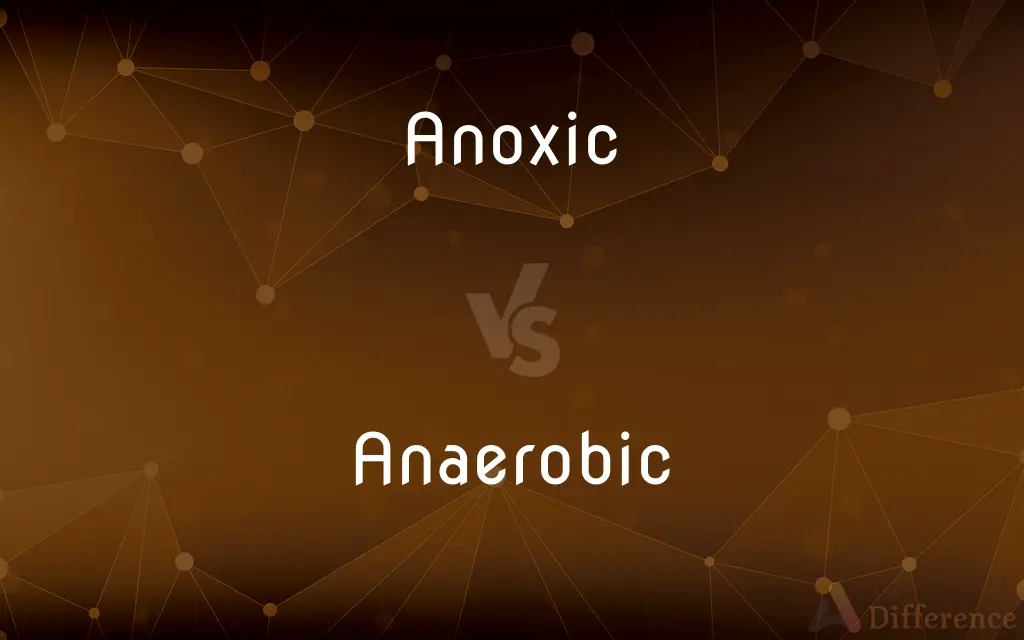Anoxic vs. Anaerobic — What's the Difference?
By Tayyaba Rehman & Urooj Arif — Updated on April 20, 2024
Anoxic conditions lack any oxygen, crucial for processes like aerobic respiration, while anaerobic conditions simply do not require oxygen, supporting life forms that thrive without it.

Difference Between Anoxic and Anaerobic
Table of Contents
ADVERTISEMENT
Key Differences
Anoxic environments are completely devoid of oxygen, making them inhospitable for organisms that rely on oxygen for metabolism. Whereas, anaerobic environments may contain minimal to no oxygen but specifically support organisms that use anaerobic processes to generate energy.
In anoxic conditions, chemical reactions and biological processes are severely limited due to the absence of oxygen, a key electron acceptor. On the other hand, in anaerobic conditions, alternative electron acceptors like sulfate or nitrate are utilized, allowing certain biochemical processes to proceed.
Anoxic waters can result from factors like eutrophication, where oxygen is depleted from water bodies due to excessive nutrients. Whereas, anaerobic conditions are often found in natural settings such as deep-sea vents and wetlands, where oxygen penetration is naturally restricted.
Anoxic zones in oceans are critical in understanding global nitrogen cycles as they are sites for processes like denitrification. Conversely, anaerobic environments are studied for their role in methane production and other unique biological pathways.
Anoxic conditions often lead to the buildup of harmful substances like hydrogen sulfide, which can be toxic to marine life. Meanwhile, anaerobic organisms often produce energy through fermentation, a process that doesn't require oxygen and yields different byproducts like alcohol or organic acids.
ADVERTISEMENT
Comparison Chart
Oxygen Presence
None
Minimal to none
Environment Examples
Deep ocean trenches, some lakes
Wetlands, guts, rumens
Chemical Processes
Limited due to lack of electron acceptors
Utilizes alternative electron acceptors like nitrate
Biological Impact
Inhibits aerobic life forms
Supports specific anaerobes
Typical Byproducts
Hydrogen sulfide
Methane, alcohols, acids
Compare with Definitions
Anoxic
Detrimental to aerobic organisms.
Fish cannot survive in anoxic waters.
Anaerobic
Can lead to the production of distinctive chemical byproducts.
Anaerobic decomposition in wetlands releases methane.
Anoxic
Characterized by a total lack of oxygen.
Anoxic conditions in the lake occur due to over-fertilization.
Anaerobic
Produces energy via processes like fermentation.
Yeast performs anaerobic respiration to produce alcohol.
Anoxic
Completely free from oxygen.
The deep sea is an anoxic environment where no light or oxygen penetrates.
Anaerobic
Occurring without the presence of oxygen.
Anaerobic bacteria thrive in environments devoid of oxygen.
Anoxic
Associated with extreme environments.
Anoxic zones are critical areas for studying microbial life.
Anaerobic
Supports life forms that derive energy without oxygen.
Anaerobic microbes play essential roles in the gut microbiome.
Anoxic
Affects chemical and biological processes.
The anoxic state of the mud preserved the ancient artifacts well.
Anaerobic
Can occur in both natural and artificial environments.
Anaerobic digestion tanks help in waste management.
Anoxic
Absence of oxygen.
Anaerobic
Relating to or requiring an absence of free oxygen
Anaerobic bacteria
Anoxic
A pathological deficiency of oxygen, especially hypoxia.
Anaerobic
Living or occurring in the absence of free oxygen
Anaerobic bacteria.
Anoxic
(pathology) Suffering from a reduced supply of oxygen.
Anaerobic
Of or relating to anaerobes.
Anoxic
Lacking oxygen.
Anaerobic
Without oxygen; especially of an environment or organism.
Anoxic
Of, pertaining to, or suffering from, anoxia.
Anaerobic
Of exercise, involving glycolysis (the conversion of glucose to adenosine triphosphate) rather than using oxygen to supply bodily energy needs.
Anoxic
Greatly deficient in, or totally lacking, oxygen.
Anaerobic
Of or relating to an anaerobe.
Anoxic
Relating to or marked by a severe deficiency of oxygen in tissues or organs
Anaerobic
Not requiring air or oxygen for life; - applied especially to those microbes to which free oxygen is unnecessary; anaërobiotic; - opposed to aërobic.
Anaerobic
Relating to, or like, anaërobies; anaërobiotic.
Anaerobic
Living or active in the absence of free oxygen;
Anaerobic bacteria
Anaerobic
Not aerobic;
Isometric exercises are anaerobic
Common Curiosities
How do organisms survive in anaerobic conditions?
Organisms in anaerobic conditions utilize processes like fermentation or use alternative electron acceptors to survive without oxygen.
What are some natural anaerobic environments?
Natural anaerobic environments include swamps, marshes, and the guts of certain animals.
Are anoxic and anaerobic conditions the same?
No, anoxic conditions mean absolutely no oxygen is present, while anaerobic conditions refer to environments where oxygen is not required for life.
What happens to marine life in anoxic conditions?
Marine life typically cannot survive in anoxic conditions due to the lack of oxygen necessary for their survival.
Can anoxic conditions be artificially created?
Yes, anoxic conditions can be artificially created in laboratories or industrial processes to simulate extreme environments or for specific chemical reactions.
What defines an anoxic environment?
An anoxic environment is characterized by a complete absence of oxygen.
Why are anoxic zones important in oceanography?
Anoxic zones are important for studying nutrient cycles, particularly the nitrogen cycle, and their impact on marine ecosystems.
What role do anaerobic bacteria play in the environment?
Anaerobic bacteria play crucial roles in nutrient cycling, such as in the digestion processes of ruminants and in decomposing organic matter in soil.
What type of metabolism do anaerobic organisms use?
Anaerobic organisms typically use anaerobic metabolism, such as fermentation, to generate energy.
Is it possible for an environment to be both anoxic and anaerobic?
Yes, an environment can be both if it is completely devoid of oxygen and supports life forms that do not require oxygen.
Share Your Discovery

Previous Comparison
Ronin vs. Samurai
Next Comparison
Admonish vs. RebukeAuthor Spotlight
Written by
Tayyaba RehmanTayyaba Rehman is a distinguished writer, currently serving as a primary contributor to askdifference.com. As a researcher in semantics and etymology, Tayyaba's passion for the complexity of languages and their distinctions has found a perfect home on the platform. Tayyaba delves into the intricacies of language, distinguishing between commonly confused words and phrases, thereby providing clarity for readers worldwide.
Co-written by
Urooj ArifUrooj is a skilled content writer at Ask Difference, known for her exceptional ability to simplify complex topics into engaging and informative content. With a passion for research and a flair for clear, concise writing, she consistently delivers articles that resonate with our diverse audience.














































